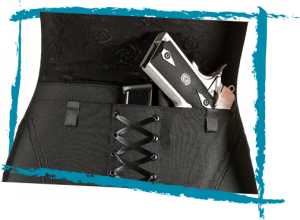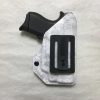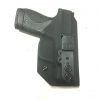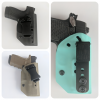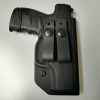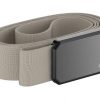First things first, right? So, what is a holster anyway? Simply put, a holster is a device for securing a firearm on your body, providing access to and (in most cases) concealment of said firearm. Notice these three words: secure, access, concealment. These are the three most important attributes of any holster, followed closely by comfort.
Secure
Any holster you choose absolutely must keep the firearm secure. At a minimum, this means that the trigger guard is completely covered and the firearm remains secured while you move, run, jump, drive, and generally do the things you normally do in your daily life. Holsters employ many different types of devices to make sure the firearm remains secure. Few holster types offer better security than the belly-band type. One of our favorites is the Hip Slimmer, made by a great company right here in Florida.
Access
A firearm that is totally secured in a holster will do very little to protect you if you are unable to access it when you need it the most. Removing the firearm from the holster should be easy from various positions and the holster should remain stable, allowing for a smooth and consistent, and thus, reliable draw every time. We prefer a minimalist approach most of the time here in the heat of south Florida and the Naples, Florida based Sticky Holster and its modular approach makes it simple for you to put the holster anywhere on your body, where you can easily access it.
Concealment
Although this is not an issue for those lucky people legally allowed to open carry…for this discussion we will assume a concealed carry situation. A holster that provides great security and access is unusable if it telegraphs the location of your supposedly concealed firearm. Although body type, holster position, and clothing choice influence concealment as well, the holster design itself plays a major role. For women who like to wear form fitting dresses, concealment can be a challenge and for this situation we like this Under-Arm Bra Holster.
Comfort
If you plan on carrying a firearm every day, comfort should play a role in your holster choice. Position and the use of different materials play a role in how each holster feels to its wearer. If you are new to concealed carry, you should expect some minimal level of discomfort at first as you get used to the weight and overall feeling of having a firearm pressed against you at all times. However, this should not take long to overcome and your holster should never cause any pain or other lasting discomfort. Again, we like the Sticky Holster because of its lightweight and durable design.
Position
There are many different positions in which to wear a holster. Generally speaking, the most popular positions are around the waist, usually at the hip, and are sometimes referred to like time on a clock with the right hip side being called 3 o’clock. Sometimes the position is referred to as being strong side – on the same side of the body as the dominant hand- or, weak side- on the same side as the non-dominant hand. In the front of either side of the body (approximately 1-2 o’clock) is also called appendix carry and in the back (6 o’clock) is called small-of-the-back carry or kidney carry slightly to one side or the other. Another designation is inside the waistband (IWB) or outside the waistband (OWB), depending on whether or not the holster is secured to the belt on the outside of the pants or tucked inside the pants. Holsters can be tuckable, meaning a shirt can be tucked into the pants covering the holster and firearm, leaving only the attachment loops exposed on the belt.
Of course, there are many other positions such as inside a pants pocket, around an ankle, under a shoulder, strapped to the thigh, hooked around the center of a bra, tucked into specialized undergarments, snugged into a stretchy bellyband, or utilizing what is referred to as off-body carry, with the holster secured inside a purse, fanny pack or other specialized bag.
Check out our wide variety of holsters by position or you can search by your specific gun model.
Materials
The types of materials used to make holsters are as varied as the positions in which they can be located. The most popular choices are leather and nylon for “soft” style holsters and kydex or other molded plastic for “hard” style holsters. Many times a holster will combine two or more materials to increase comfort and/or security. There are other specialized materials, such as neoprene, Velcro, and stretchable/breathable nylon that are used for various reasons. Some companies, like Sticky Holsters, have selected a type of material that increases both comfort and security while remaining lightweight and durable.
Ride and Cant
These are two words you will hear when describing holsters. The ride of the holster refers to how low or high the firearm sits, usually in relation to the waist or belt line. A deep riding holster will keep the firearm’s trigger below the belt line and offer more concealment. A high riding holster may offer better access and comfort but may be harder to conceal. The cant of a holster refers to the angle at which the firearm is held while secured in the holster. A straight-drop (vertical) cant keeps the muzzle pointed directly at the ground while holstered while an FBI-cant angles the grip forward (muzzle backward) between 10-20 degrees. Usually, more cant offers better concealment and easier draw. However, ride and cant choices are personal preferences that you will develop over years of carrying your firearm on a daily basis.

